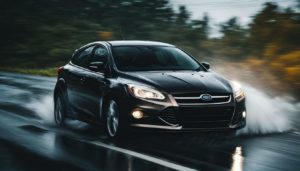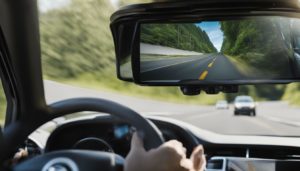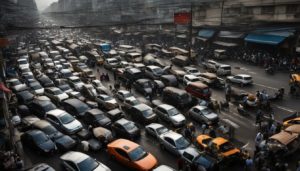Challenges of City Driving
City driving presents a multitude of challenges that require drivers to be alert and adaptive. Navigating busy urban streets can be a daunting task, with numerous hurdles to overcome. From congested traffic to parking difficulties, drivers face a range of obstacles on a daily basis. In this article, we will delve into the challenges of city driving and provide helpful tips for successfully navigating these urban driving challenges.
Key Takeaways:
- Sharing the road with various types of traffic and pedestrians
- Sudden changes in road conditions and speed limits
- Frequent intersections and crossing multiple lanes of traffic
- Parked cars blocking visibility and limited space for maneuvering
- Stop-and-go traffic leading to frustration and road rage
City driving requires drivers to be proactive in identifying and avoiding potential hazards, such as delivery personnel walking around, pedestrians crossing unpredictably, and distracting sounds and sights. It also necessitates careful management of visibility, space, and time to ensure a safe journey. New drivers can benefit from practicing defensive driving techniques, anticipating other drivers' actions, and exercising caution in congested areas. By being aware of the challenges and adopting the right strategies, drivers can navigate city streets with confidence and stay safe on the road.
Dealing with Congested Traffic
Congested traffic is a common challenge that drivers face when navigating city streets. The hustle and bustle of urban areas often result in traffic jams and frustrating delays. However, with some strategic planning and a few simple techniques, you can successfully navigate through congested roads and reach your destination with minimal stress.
One effective strategy is to stay alert and maintain a safe following distance. This allows you to anticipate sudden stops and prevents rear-end collisions. Additionally, using navigation apps or studying alternative routes in advance can help you avoid heavily congested areas and find quicker paths to your destination.
| Tip | Description |
|---|---|
| 1 | Consider commuting during off-peak hours to avoid rush hour traffic. |
| 2 | Use public transportation or carpooling options when available to reduce the number of vehicles on the road. |
| 3 | Stay patient and avoid aggressive driving behaviors such as frequent lane changes or tailgating, as they can escalate tensions and increase the risk of accidents. |
Remember, it's crucial to stay focused and attentive while navigating through congested traffic. Avoid distractions such as checking your phone or engaging in lengthy conversations. By practicing defensive driving techniques and adopting a calm mindset, you can alleviate the frustrations of congested traffic and ensure a safe and relaxed commuting experience in the city.
Parking Issues in the Urban Jungle
Finding a parking spot in the city can be a daunting task for even the most experienced drivers. With limited parking spaces and a constant stream of vehicles, navigating through the urban jungle can feel like a never-ending quest. However, there are strategies you can utilize to increase your chances of finding that elusive parking spot.
Firstly, it's important to plan ahead and research the parking options available in the area you're visiting. Look for nearby parking garages or lots that may offer more spaces compared to street parking. Many cities now have mobile apps or websites that provide real-time information on available parking spots, making it easier to find a vacant space.
Another tip is to be flexible with your parking preferences. While finding a spot right in front of your destination may be convenient, it's often more challenging. Consider parking a few blocks away or in less crowded areas where you have a higher chance of finding an available spot. Additionally, don't overlook alternative parking solutions such as valet services or shared parking spaces, which can provide a convenient solution in busy urban areas.
| Parking Tips: |
|---|
| Research parking options in advance |
| Utilize mobile apps or websites for real-time parking information |
| Be flexible with your parking preferences |
| Consider alternative parking solutions |
Lastly, timing is key when it comes to finding parking in the city. Avoid peak hours where parking demand is high, such as during weekdays or weekends when popular events are taking place. Instead, opt for off-peak hours or less busy days to improve your chances of securing a parking spot.
The Importance of Patience
“Parking in the city requires a blend of strategy, luck, and a good dose of patience. It may take a few rounds around the block or a bit of walking, but with perseverance, you'll eventually find that coveted parking spot.”
In conclusion, parking issues in the urban jungle can be frustrating, but with careful planning, flexibility, and patience, it's possible to navigate through the challenges. Remember to utilize available resources, explore alternative parking options, and be mindful of timing. By adopting these strategies, you'll be better equipped to conquer the parking woes and enjoy your urban adventures to the fullest.
Dealing with Aggressive Drivers and Road Rage
Sharing the road with aggressive drivers can make city driving a stressful experience. The constant honking, tailgating, and sudden lane changes can leave even the most seasoned drivers on edge. It's important to stay calm and focused while navigating through these challenging situations. Here are some tips for dealing with aggressive drivers and avoiding road rage:
- Keep your cool: When confronted with an aggressive driver, it's natural to feel the urge to retaliate. However, escalating the situation will only make matters worse. Take a deep breath, remain calm, and focus on your own driving.
- Maintain a safe distance: Aggressive drivers tend to weave in and out of traffic, making sudden lane changes without signaling. Give yourself plenty of space by maintaining a safe following distance. This will not only protect you from potential collisions but also give you more time to react to their unpredictable maneuvers.
- Avoid eye contact: Engaging in eye contact with an aggressive driver can escalate the situation. Instead, keep your focus on the road ahead and ignore any provocative gestures or comments.
- Report dangerous behavior: If you witness an aggressive driver putting others at risk, report them to the appropriate authorities. Jot down their license plate number, a description of the vehicle, and any relevant details. By taking action, you can help keep the roads safer for everyone.
Remember, it's crucial to prioritize your safety and the safety of others. Defensive driving techniques, such as anticipating other drivers' actions, can go a long way in avoiding confrontations and staying out of harm's way. By staying calm and focused, you can navigate through city traffic with confidence and minimize the impact of aggressive drivers on your driving experience.
Aggressive Driving Statistics
According to the National Highway Traffic Safety Administration (NHTSA), aggressive driving contributes to a significant number of accidents on the road. Here are some eye-opening statistics:
| Aggressive Driving Behavior | Percentage of Fatal Crashes |
|---|---|
| Excessive Speeding | 30% |
| Tailgating | 24% |
| Failure to Yield | 18% |
| Running Red Lights | 16% |
These statistics emphasize the importance of staying alert and cautious while sharing the road with aggressive drivers. By being aware of the risks associated with aggressive driving behaviors, you can take proactive measures to protect yourself and others on the road.
Navigating Pedestrian Hazards
Driving in the city requires constant vigilance to avoid potential collisions with pedestrians. With the hustle and bustle of busy streets, it's important to stay alert and aware of your surroundings at all times. Distracted driving is a major concern, as both drivers and pedestrians can become easily distracted by their phones or other distractions. It's crucial to prioritize the safety of pedestrians and take proactive measures to avoid accidents.
Identifying Hazards and Avoiding Obstacles
When driving in areas with high pedestrian activity, it's essential to anticipate potential hazards and adapt your driving accordingly. Keep an eye out for pedestrians who may be crossing the street unexpectedly or jaywalking. Be cautious at intersections and always yield the right of way to pedestrians. Watch for delivery personnel walking around and be prepared for vehicles pulling out unexpectedly from parking spaces.
Visibility, space, and time management are key factors in safely navigating pedestrian-heavy areas. Parked cars can block your view, so exercise caution and reduce your speed when approaching areas where visibility is limited. Maintain a safe following distance, keeping enough space between your vehicle and pedestrians to allow for any sudden changes in their movement.
Keeping a Watchful Eye and Practicing Defensive Driving
Being aware of your surroundings is crucial to avoiding accidents with pedestrians. Pay attention to distracting sounds and sights, such as sirens, honking horns, or pedestrians crossing at unexpected locations. Scan the environment and use your mirrors frequently to keep track of pedestrians and other vehicles around you.
Remember to always practice defensive driving techniques in the city. Anticipate the actions of other drivers and pedestrians, and be prepared to react quickly if necessary. Stay calm and patient, avoiding road rage and aggressive behaviors that could endanger both yourself and pedestrians.
| Key Tips for Navigating Pedestrian Hazards |
|---|
| 1. Stay alert and avoid distractions while driving. |
| 2. Yield the right of way to pedestrians at intersections. |
| 3. Watch for delivery personnel and vehicles pulling out unexpectedly. |
| 4. Reduce speed in areas with limited visibility due to parked cars. |
| 5. Maintain a safe following distance from pedestrians. |
| 6. Be aware of distracting sounds and sights. |
| 7. Practice defensive driving and anticipate the actions of others. |
| 8. Stay calm and avoid road rage or aggressive behaviors. |
Maneuvering through Narrow Roads and Intersections
City driving often requires drivers to navigate through tight spaces and frequent intersections. These challenges can be especially daunting for new drivers who may not be accustomed to such conditions. When maneuvering through narrow roads and busy intersections, it is important to be prepared and remain focused on the road ahead. Here are some tips to help you navigate these challenging situations:
- Use your mirrors: Before making any turns or changing lanes, always check your mirrors to ensure there are no vehicles or pedestrians in your blind spots. This is especially crucial when driving on narrow roads where visibility may be limited.
- Take it slow: When faced with a narrow road or intersection, reduce your speed to give yourself more time to react to any unexpected obstacles or hazards. Remember, it's better to be safe than sorry.
- Signal your intentions: Proper use of turn signals is essential when navigating through tight spaces. Clearly indicating your intention to turn or change lanes allows other drivers to anticipate your actions, reducing the risk of collisions or misunderstandings.
Remember, defensive driving is key when maneuvering through narrow roads and intersections. Stay alert, anticipate potential hazards, and always be prepared to take evasive action. By following these tips, you can navigate through city streets with confidence and ensure a safe and pleasant driving experience.
Avoiding obstacles and anticipating pedestrians
One of the biggest challenges in navigating narrow city roads and intersections is avoiding obstacles and anticipating the movements of pedestrians. With limited space and unpredictable pedestrian behavior, it's important to stay vigilant. Here are a few things to keep in mind:
- Be aware of pedestrians: Whether they're jaywalking or using designated crosswalks, always be on the lookout for pedestrians. Avoid distractions and keep your focus on the road to ensure you can react quickly if someone crosses your path unexpectedly.
- Plan your route: If you're familiar with the area, plan your route in advance to avoid narrow roads or intersections that you find particularly challenging. This can help reduce stress and increase your confidence as you navigate through the city.
- Give room to parked cars: When passing parked cars, be sure to leave enough space to account for any sudden opening of car doors. This is especially important on narrow roads where parked cars can obstruct your visibility.
| Challenges of Maneuvering through Narrow Roads and Intersections | Tips for Safer Driving |
|---|---|
| Limited visibility due to parked cars | Reduce speed and use your mirrors effectively to maintain awareness of your surroundings |
| Pedestrians crossing unpredictably | Stay alert and anticipate pedestrian movements, especially near crosswalks and busy intersections |
| Identifying hazards and avoiding obstacles | Scan the road ahead and be prepared to react quickly to any unexpected obstacles or hazards |
By practicing defensive driving techniques and following these tips, you can navigate through narrow roads and intersections in the city with ease. Remember, patience and caution are key when driving in urban environments. Stay aware of your surroundings, anticipate potential challenges, and always prioritize safety for yourself and others on the road.
Conclusion
City driving presents a unique set of challenges that drivers must navigate with caution and adaptability. From the congested streets to parking difficulties and aggressive drivers, urban driving requires a heightened sense of awareness and defensive driving techniques. It's crucial to anticipate the actions of other drivers and stay focused on the road at all times.
One of the major challenges of city driving is dealing with congested traffic. Stop-and-go traffic can be frustrating, but it's important to remain patient and maintain a safe following distance. Planning your routes in advance and utilizing real-time traffic updates can help you navigate through congested areas more efficiently.
Finding parking in the urban jungle can be a daunting task. Limited parking spaces and parallel parking can cause stress, but being patient and persistent is key. Consider alternative parking options such as parking garages or public transportation, and always obey parking regulations to avoid fines or towing.
Another challenge of city driving is encountering aggressive drivers and road rage. It's crucial to maintain your composure and avoid escalating confrontations. If you encounter an aggressive driver, try to create distance and report any dangerous behavior to the authorities. Remember to stay calm and focused on your own safety.
Navigating through areas with heavy pedestrian activity requires extra caution. Distracted pedestrians and jaywalking can create unexpected hazards. Always be on the lookout for pedestrians, especially in busy crosswalks and intersections. Avoid distractions in the car and be prepared to react to pedestrians' actions.
Maneuvering through narrow roads and frequent intersections can be challenging in bustling city environments. Cross-check your blind spots, be mindful of parked cars blocking visibility, and take your time to safely navigate through these tight spaces. It's crucial to exercise patience and always yield to other drivers when necessary.
City driving may seem daunting, but with practice and a vigilant approach, it is possible to overcome the challenges. Defensive driving techniques, anticipating other drivers' actions, and exercising caution can help ensure a safe and enjoyable driving experience in the city. Remember, patience and adaptability are key to conquering the urban jungle.
FAQ
What are the challenges of city driving?
Challenges of city driving include sharing the road with various types of traffic and pedestrians, sudden changes in road conditions and speed limits, frequent intersections, crossing multiple lanes of traffic, parked cars blocking visibility, stop-and-go traffic leading to frustration and road rage, vehicles pulling out unexpectedly, delivery personnel walking around, pedestrians crossing unpredictably, distracting sounds and sights, visibility, space, and time management, identifying hazards, avoiding obstacles, dealing with other drivers, navigating congested roads, and watching out for pedestrians crossing at unexpected locations.
How should new drivers navigate congested areas?
New drivers should practice defensive driving, anticipate other drivers' actions, and exercise caution in congested areas.
What strategies can drivers use to deal with congested traffic?
Strategies for dealing with congested traffic include staying calm, maintaining a safe distance from the vehicle ahead, using alternate routes when available, and being patient.
What are some parking issues drivers face in urban areas?
Parking issues in urban areas include limited parking spaces, parallel parking difficulties, and the risk of parking violations or fines.
How can drivers cope with aggressive drivers and road rage?
Drivers can cope with aggressive drivers and road rage by staying calm, avoiding confrontation, and reporting dangerous driving behaviors to the appropriate authorities if necessary.
What should drivers be aware of when navigating areas with heavy pedestrian activity?
When navigating areas with heavy pedestrian activity, drivers should be aware of distracted pedestrians, jaywalking, and the need to yield to pedestrians at crosswalks.
What tips can drivers follow to safely maneuver through narrow roads and frequent intersections?
Tips for safely maneuvering through narrow roads and frequent intersections include taking extra caution, signaling intentions clearly, checking blind spots, and being aware of pedestrians and cyclists.
What is the importance of defensive driving in city environments?
Defensive driving techniques are crucial in city environments to anticipate and respond to potentially dangerous situations, maintain awareness of surrounding vehicles and pedestrians, and ensure a safe driving experience.



